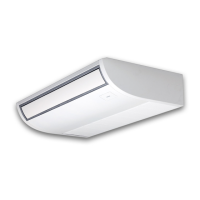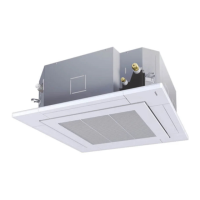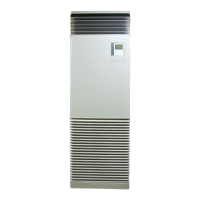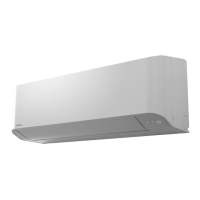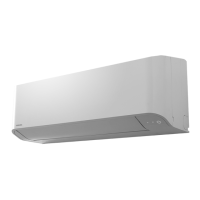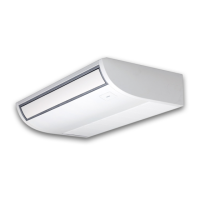
Do you have a question about the Toshiba RAV-HM401CTP Series and is the answer not in the manual?
| Brand | Toshiba |
|---|---|
| Model | RAV-HM401CTP Series |
| Category | Air Conditioner |
| Language | English |
Defines the qualifications and knowledge required for installation and service personnel.
Details protective gear required for various work tasks to ensure safety.
Explains the meaning of indications and illustrated marks used in the manual.
Explains symbols used on the air conditioner unit itself, particularly regarding refrigerant safety.
Confirms placement of warning labels on the main unit and their meaning.
Outlines critical safety measures for immediate severe harm or serious injury.
Covers earth wiring, modifications, parts, and proximity warnings.
Details precautions for electrical work, heights, handling, and transport.
Highlights pressure and oil changes associated with R32 refrigerant and necessary precautions.
Provides specific advice on tools, pipes, and handling R32 refrigerant during installation and service.
Specifies requirements for pipes and lists required tools for R32 handling.
Procedures for finding and repairing refrigerant leaks and managing gas hazards.
Essential checks after repair work, including test runs and pipe connections.
Safety measures for installing the air conditioner, including room size and electrical setup.
Safety considerations and procedures for relocating the air conditioner unit.
Declares conformity of specific air conditioner models with directives and regulations.
Declares conformity of specific air conditioner models with UK machinery regulations.
Lists sound pressure level and weight for different air conditioner models.
Detailed technical specifications for cooling, heating, power, and dimensions of indoor and outdoor units.
Detailed technical specifications for larger capacity indoor and outdoor units.
Safety precautions related to the characteristics and handling of R32 refrigerant.
Specific warnings for installing and servicing systems using R32 refrigerant.
Specifies requirements for pipes and lists required tools for R32 handling.
Lists tools specifically required for R32 refrigerant handling and installation.
Lists common tools that can also be used for R22 and R32 installations.
External views and dimensions of the RAV-HM401CTP and RAV-HM561CTP indoor units.
External views and dimensions of the RAV-HM801CTP indoor unit.
External views and dimensions of larger capacity indoor units.
Illustrates refrigerant cycles for single and twin indoor/outdoor unit combinations.
Illustrates the refrigerant cycle for a triple indoor and outdoor unit combination.
Illustrates the refrigerant cycle for a double-twin indoor and outdoor unit combination.
Shows the electrical connections and wiring for the indoor unit.
Lists specifications for electrical components like fan motors and sensors for indoor units.
Illustrates the internal components and connections of the indoor unit's control system.
Details the connection of a wired remote controller to the indoor unit's control circuit.
Details the connection of a wireless remote controller kit to the indoor unit's control circuit.
Covers behavior on power reset and how to select operation modes via remote controller.
Explains temperature adjustment range and correction values based on outside temperature.
Details temperature correction using CODE No. 06 and room temperature control logic.
Explains automatic capacity control and logic for switching between cooling and heating.
Explains how air speed is selected and adjusted automatically in COOL and HEAT modes.
Details fan speed selection codes, revolution speeds, and self-clean operation.
Controls indoor fan to prevent cold air discharge and protect against freezing.
Manages overheating and drain pump operations, including optional drain pump control.
Controls indoor fan operation after heating stops to eliminate residual heat.
Explains louver position setup, swing, and automatic adjustments.
Details HA control and procedures for performing frequency fixed test runs.
Explains how the filter reset signal is sent and displayed on the remote controller.
Covers central control, energy saving, and max frequency cut controls.
Describes DC motor operation, positioning, and error detection.
Details self-clean operations and power saving modes.
Describes the drain pump's continued operation after cooling stops.
Provides objective heating at 8°C for cold climates and frost protection.
Explains occupancy sensor operation and automatic switching to absence mode.
Covers soft cooling for draft reduction and dual set point for AUTO mode.
Configures fan speed and prevents cold air downdraft during defrost.
Sets communication type and enables alternating/backup operations for multiple units.
Details rotation/backup settings and defrost start time adjustments.
Limits power consumption to balance loads and improve efficiency in unbalanced situations.
Enables energy-saving operations using outdoor temperature in cooling mode.
Explains secondary heating operation in normal and flip modes based on temperature differences.
Details secondary heating mode settings, temperatures, and wiring connections.
Identifies components and connectors on the MCC-1643 indoor P.C. board.
Details pin assignments and functions for optional connectors on the indoor P.C. board.
Lists required tools and initial confirmation points for troubleshooting wired remote controller systems.
Outlines the general procedure: confirm code, check parts, and identify defects.
Lists required tools and initial confirmation points for troubleshooting wireless remote controller systems.
Outlines the general procedure: confirm signal lamp, check parts, and identify defects.
Explains how to interpret operation, timer, and ready lamp states for diagnosing issues.
Lists check codes E01-E18, their causes, and associated lamp indications for indoor unit problems.
Lists additional check codes F01-L31, their causes, and lamp indications for indoor and outdoor unit issues.
Describes troubleshooting for issues like test run errors or cool/heat setting disagreements.
Detailed list of check codes for indoor unit communication, sensors, and group control.
Provides specific troubleshooting steps and measures for E03, E04, E08, L03, L07, L08, L09, L30, P10, P12, P19, F01, F02, F10 codes.
Lists check codes related to communication issues between controllers and indoor units.
Step-by-step guides to diagnose and resolve E01 and E09 communication errors.
Step-by-step guide to diagnose and resolve E04 errors involving outdoor operation and wiring.
Troubleshooting steps for E11 errors, focusing on the application control kit and its connections.
Steps for diagnosing unit address, group control, and capacity setting issues.
Troubleshooting steps for L20 (central address), L30 (outdoor devices), and P30 (central controller) troubles.
Troubleshooting steps for P10 (float switch/drain pump) and F10 (TA sensor) troubles.
Troubleshooting steps for P12 trouble related to the fan motor and its PC board.
Troubleshooting steps for P19 (4-way valve), F02 (TC sensor), and F01 (TCJ sensor) troubles.
Troubleshooting steps for F30 trouble related to the occupancy sensor.
Troubleshooting steps for C06 trouble involving the '1:1 model' connection interface.
Troubleshooting steps for E03 (header unit comms), F29 (EEPROM), and P31 (follower unit) troubles.
Table showing resistance values for temperature sensors at various temperatures.
Table showing resistance values for TD and TL sensors at various temperatures.
Steps for replacing the indoor unit's P.C. board, including data backup and setting.
Procedure to read out setting data from EEPROM using RBC-ASCU1* remote controller.
Procedure to read out setting data from EEPROM using RBC-AMTU3* remote controller.
Lists essential CODE numbers (DN) required for setting data after P.C. board replacement.
Step-by-step guide for replacing the indoor unit's P.C. board, including jumper settings and system configuration.
Detailed steps to write setting data to EEPROM using RBC-ASCU1* remote controller.
Detailed steps to write setting data to EEPROM using RBC-AMTU3* remote controller.
Lists setting data for unit types, applicable to CODE No. 10.
Lists setting data for indoor unit capacity, applicable to CODE No. 11.
Covers local setup and testing procedures for the indoor unit.
Guides on performing a test run using the remote controller for setup.
Specific instructions for test run setup using the RBC-AMTU3* remote controller.
Instructions for performing a test run using a wireless remote controller.
Overview of test run operations using the wireless remote controller.
Procedure to force defrost operation using the wired remote controller.
Explains the status indicated by LEDs on the indoor unit's P.C. board.
Procedure to set various functions using the RBC-ASCU1* remote controller.
Procedure to set various functions using the RBC-AMTU3* remote controller.
Comprehensive table listing function codes (DN) and their descriptions for configuration.
Continuation of the table listing function codes (DN) and their descriptions for configuration.
Shows display order for central control and line addresses based on communication type.
Details operation of indoor units using two remote controllers.
Instructions for setting up a remote controller as a follower using DIP switches.
Procedure for selecting wireless remote controller A or B and memorizing it.
Steps to set the A-B selection on the signal receiving unit's P.C. board.
Procedure to access the monitor mode and view sensor data using RBC-ASCU1*.
Procedure to access the monitor mode and view sensor data using RBC-AMTU3*.
Lists code numbers and data names for monitoring indoor unit parameters.
Lists code numbers and data names for monitoring outdoor unit parameters.
Procedure to check the troubleshooting history of up to 4 incidents using the RBC-ASCU1* remote controller.
Procedure to check the troubleshooting history of up to 4 incidents using the RBC-AMTU3* remote controller.
Describes the power-ON sequence, address judgment, and initial communication steps.
Lists important cautions to observe during test run operations.
Explains regular communication patterns between units after initial setup.
Details the function, block diagram, and wiring of the 1:1 model connection interface.
Covers wiring requirements and P.C. board switch setup for collective control.
Shows the external view of the P.C. board and explains the need for address setup.
Procedure for setting the central control address number via remote controller.
Outlines the automatic address setup process upon power-ON for twin/group operations.
Lists CODE numbers and data ranges for line, indoor, and group addresses.
Defines terms and illustrates system configurations for single, twin, and group operations.
Explains single group operation and manual address setting for multiple groups.
Demonstrates automatic address setup examples for standard, group, and multiple group operations.
Step-by-step guide for manually setting addresses using the remote controller.
Steps to set indoor unit and group addresses using CODE Nos. 13 and 14.
Recommends regular cleaning and maintenance of indoor/outdoor units for optimal performance.
Procedures for detaching and attaching the air intake grille and electric parts box cover.
Procedures for detaching the electric parts box and the control P.C. board.
Procedures for detaching the fan, fan case, and shaft assemblies.
Procedures for attaching the fan and shaft, including alignment and tightening.
Procedures for detaching and attaching the bearing assembly.
Procedures for detaching and attaching the fan motor.
Procedures for detaching and attaching the side cover.
Procedures for detaching and attaching the under panel.
Procedures for detaching and attaching the drain pan and its related components.
Procedures for detaching and attaching the heat exchanger assembly.
Exploded view illustration showing parts of the RAV-HM401/561CTP indoor units.
Lists part numbers, descriptions, and quantities for specific RAV-HM401/561CTP models.
Exploded view illustration showing parts of the RAV-HM801CTP indoor unit.
Lists part numbers, descriptions, and quantities for specific RAV-HM801CTP models.
Exploded view illustration for larger capacity indoor units like RAV-HM901CTP and above.
Lists part numbers, descriptions, and quantities for larger capacity RAV-HM indoor units.
Identifies and lists electrical components on the indoor unit's P.C. board for various models.
Explains concentration limits for refrigerant R32 in rooms and required ventilation measures.
